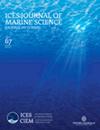Genetic monitoring uncovers long-distance marine feeding coupled with strong spatial segregation in sea trout (Salmo trutta L.) consistent at annual and decadal time scales
IF 3.4
2区 农林科学
Q1 FISHERIES
引用次数: 0
Abstract
Genetic data have greatly increased means to understand fish marine migration behaviours at large spatial scale within a quantitative framework. The anadromous sea trout is a prized target of recreational fishery and an important ecosystem component in freshwater and marine coastal habitats in large parts of temperate northern Europe. Nonetheless, little is known about population distributions while feeding at sea. To reconcile notions about feeding migrations being predominantly locally restricted or not, we used SNP data for 3465 trout representing >100 rivers to identify population origins of 903 coastally feeding fish captured throughout the North Sea-Baltic Sea transition area. Across areas, coastal collections generally showed marked stock-mixing and overall 70:30% native:non-native fish with seasonal variation corresponding with spawning run timing. Data revealed strong spatial feeding segregation between trout from the Scandinavian Peninsula and the European continent. This is surprising given the short distances between areas, but is in alignment with strong genetic differentiation between populations in these areas. Estimation of stock complexity of coastal feeding aggregations showed no spatial trend through the North Sea-Baltic Sea transition area otherwise characterized by strong environmental clines. Analyses of scale samples collected in the 1950s indicate that stock-mixing was consistent over almost 70 years.遗传监测发现海鳟(Salmo trutta L.)的远距离海洋觅食与强烈的空间隔离在年度和十年时间尺度上是一致的
基因数据大大提高了在定量框架内了解大空间尺度鱼类海洋洄游行为的手段。溯河洄游的海鳟鱼是休闲渔业的珍品,也是北欧大部分温带地区淡水和海洋沿岸栖息地生态系统的重要组成部分。然而,人们对海鳟在海上觅食时的种群分布知之甚少。为了调和觅食洄游是否主要受当地限制的观点,我们使用了代表 100 条河流的 3465 条鳟鱼的 SNP 数据,以确定在整个北海-波罗的海过渡区域捕获的 903 条沿海觅食鱼类的种群起源。在不同地区,沿岸采集的鱼类普遍表现出明显的种群混杂现象,本地鱼类与非本地鱼类的比例总体上为 70:30%,并随着产卵期的到来而出现季节性变化。数据显示,斯堪的纳维亚半岛和欧洲大陆的鳟鱼之间存在强烈的空间摄食隔离。由于区域间距离很短,这种情况令人吃惊,但却与这些地区种群间强烈的遗传分化相吻合。在北海-波罗的海过渡区,对沿岸觅食群的种群复杂性的估算没有显示出空间趋势,否则该区域的特点就是强烈的环境克隆。对 20 世纪 50 年代收集的鳞片样本进行的分析表明,种群混合在近 70 年的时间里是一致的。
本文章由计算机程序翻译,如有差异,请以英文原文为准。
求助全文
约1分钟内获得全文
求助全文
来源期刊

ICES Journal of Marine Science
农林科学-海洋学
CiteScore
6.60
自引率
12.10%
发文量
207
审稿时长
6-16 weeks
期刊介绍:
The ICES Journal of Marine Science publishes original articles, opinion essays (“Food for Thought”), visions for the future (“Quo Vadimus”), and critical reviews that contribute to our scientific understanding of marine systems and the impact of human activities on them. The Journal also serves as a foundation for scientific advice across the broad spectrum of management and conservation issues related to the marine environment. Oceanography (e.g. productivity-determining processes), marine habitats, living resources, and related topics constitute the key elements of papers considered for publication. This includes economic, social, and public administration studies to the extent that they are directly related to management of the seas and are of general interest to marine scientists. Integrated studies that bridge gaps between traditional disciplines are particularly welcome.
 求助内容:
求助内容: 应助结果提醒方式:
应助结果提醒方式:


